Stem cells culled from bone marrow may prove beneficial in stroke recovery, scientists at UC Irvine’s Sue & Bill Gross Stem Cell Research Center have learned.
In an analysis of published research, neurologist Dr. Steven Cramer and biomedical engineer Weian Zhao identified 46 studies that examined the use of mesenchymal stromal cells – a type of multipotent adult stem cells mostly processed from bone marrow – in animal models of stroke. They found MSCs to be significantly better than control therapy in 44 of the studies.
Importantly, the effects of these cells on functional recovery were robust regardless of the dosage, the time the MSCs were administered relative to stroke onset or the method of administration. (The cells helped even if given a month after the event and whether introduced directly into the brain or injected via a blood vessel.)
“Stroke remains a major cause of disability, and we are encouraged that the preclinical evidence shows [MSCs’] efficacy with ischemic stroke,” said Cramer, a professor of neurology and leading stroke expert. “MSCs are of particular interest because they come from bone marrow, which is readily available, and are relatively easy to culture. In addition, they already have demonstrated value when used to treat other human diseases.”
He noted that MSCs do not differentiate into neural cells. Normally, they transform into a variety of cell types, such as bone, cartilage and fat cells. “But they do their magic as an inducible pharmacy on wheels and as good immune system modulators, not as cells that directly replace lost brain parts,” he said.
In an earlier report focused on MSC mechanisms of action, Cramer and Zhao reviewed the means by which MSCs promote brain repair after stroke. The cells are attracted to injury sites and, in response to signals released by these damaged areas, begin releasing a wide range of molecules. In this way, MSCs orchestrate numerous activities: blood vessel creation to enhance circulation, protection of cells starting to die, growth of brain cells, etc. At the same time, when MSCs are able to reach the bloodstream, they settle in parts of the body that control the immune system and foster an environment more conducive to brain repair.
“We conclude that MSCs have consistently improved multiple outcome measures, with very large effect sizes, in a high number of animal studies and, therefore, that these findings should be the foundation of further studies on the use of MSCs in the treatment of ischemic stroke in humans,” said Cramer, who is also clinical director of the Sue & Bill Gross Stem Cell Research Center.
The analysis appears in the April 8 issue of Neurology
Source: UCI rvine


